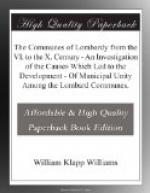The economic changes which were produced by the transition to the new principles represented by the feudal system, are as great and in their way as important as the political ones. When we say that feudalism represents the transfer of the dominant power from a central head to scattered members, from the capital to the castles, we speak of it in its most prominent, its political character. But we must not forget that this transfer also meant a great economic change in the organization of society: that it meant a transfer of the seat of economic importance from the city to the country; the spirit of the times requiring, especially in the earlier stages of the development of the institution, that the seat of wealth should follow the seat of power. I note this now because we shall soon have occasion to consider how important a factor, in the earliest period of the development of the cities, their entire lack of prominence in both political and economic affairs was to prove itself. Under the old Roman system, as we have seen, the city was the important unit: Rome was a subduer and an upbuilder of cities. Under the new Teutonic element the land is what is brought into prominence, and the possessor of it into power. The dominant member of society is the landowner and not the citizen. In ancient society the “citizen” need own no land; in the modern society of the feudal age, the “gentleman” could not be such without owning land.
This opposition between the citizen, the burgher, and the landowner, the baron, leads us to a conclusion of the utmost importance to the whole study of city life during the middle ages. We note the universal prevalence of the forms characteristic of the feudal system, and from this we conclude that its principles were as universally adopted. Now this is to a certain extent an error. There were certain institutions which from the very nature of their origin and of the principles on which they were based, must have been, at once in their idea and in their structure, opposed to the fundamental principle of feudalism. The Roman Church, for example, conformed itself to the forms and customs of this system, but never lost its structural unity and centralization, ideas founded on principles which stood in direct opposition to those of feudalism. So it was, though perhaps in a less degree, with the cities. Though adapting themselves in many ways to feudal forms, here the idea of democracy was as




